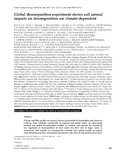| dc.contributor.author | Voigt, W | |
| dc.contributor.author | Wolters, V | |
| dc.contributor.author | Gardel, HZ | |
| dc.contributor.author | Ayuke, FO | |
| dc.date.accessioned | 2013-07-01T07:14:49Z | |
| dc.date.available | 2013-07-01T07:14:49Z | |
| dc.date.issued | 2008 | |
| dc.identifier.citation | Global Change Biology Volume 14, Issue 11, pages 2661–2677, November 2008 | en |
| dc.identifier.uri | http://onlinelibrary.wiley.com/doi/10.1111/j.1365-2486.2008.01672.x/full | |
| dc.identifier.uri | http://erepository.uonbi.ac.ke:8080/xmlui/handle/123456789/43116 | |
| dc.description.abstract | Climate and litter quality are primary drivers of terrestrial decomposition and, based on evidence from multisite experiments at regional and global scales, are universally factored into global decomposition models. In contrast, soil animals are considered key regulators of decomposition at local scales but their role at larger scales is unresolved. Soil animals are consequently excluded from global models of organic mineralization processes. Incomplete assessment of the roles of soil animals stems from the difficulties of manipulating invertebrate animals experimentally across large geographic gradients. This is compounded by deficient or inconsistent taxonomy. We report a global decomposition experiment to assess the importance of soil animals in C mineralization, in which a common grass litter substrate was exposed to natural decomposition in either control or reduced animal treatments across 30 sites distributed from 43°S to 68°N on six continents. Animals in the mesofaunal size range were recovered from the litter by Tullgren extraction and identified to common specifications, mostly at the ordinal level. The design of the trials enabled faunal contribution to be evaluated against abiotic parameters between sites. Soil animals increase decomposition rates in temperate and wet tropical climates, but have neutral effects where temperature or moisture constrain biological activity. Our findings highlight that faunal influences on decomposition are dependent on prevailing climatic conditions. We conclude that (1) inclusion of soil animals will improve the predictive capabilities of region- or biome-scale decomposition models, (2) soil animal influences on decomposition are important at the regional scale when attempting to predict global change scenarios, and (3) the statistical relationship between decomposition rates and climate, at the global scale, is robust against changes in soil faunal abundance and diversity. | en |
| dc.language.iso | en | en |
| dc.publisher | Wiley | en |
| dc.subject | Climate decomposition index | en |
| dc.subject | Decomposition | en |
| dc.subject | Litter | en |
| dc.subject | Mesofauna | en |
| dc.subject | Soil biodiversity | en |
| dc.subject | Soil carbon | en |
| dc.subject | Soil fauna | en |
| dc.title | Global decomposition experiment shows soil animal impacts on decomposition are climate‐dependent | en |
| dc.type | Article | en |
| local.publisher | Department of Land Resource Management and Agricultural Technology (LARMAT) | en |

